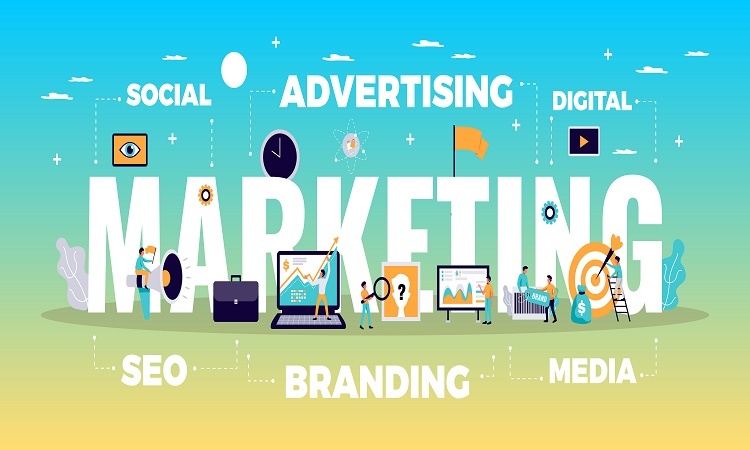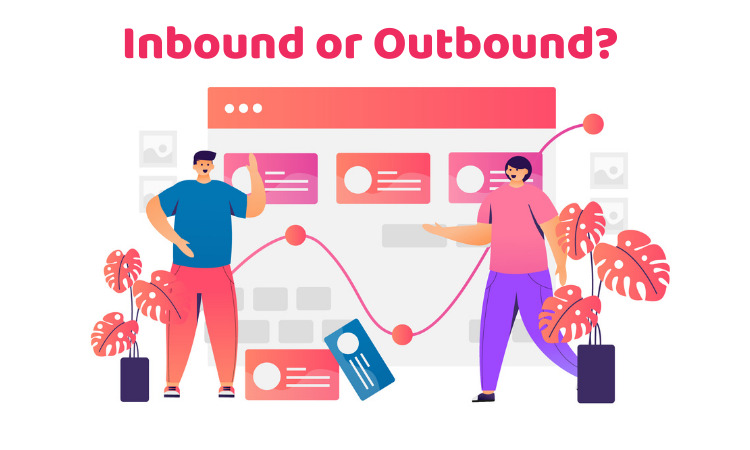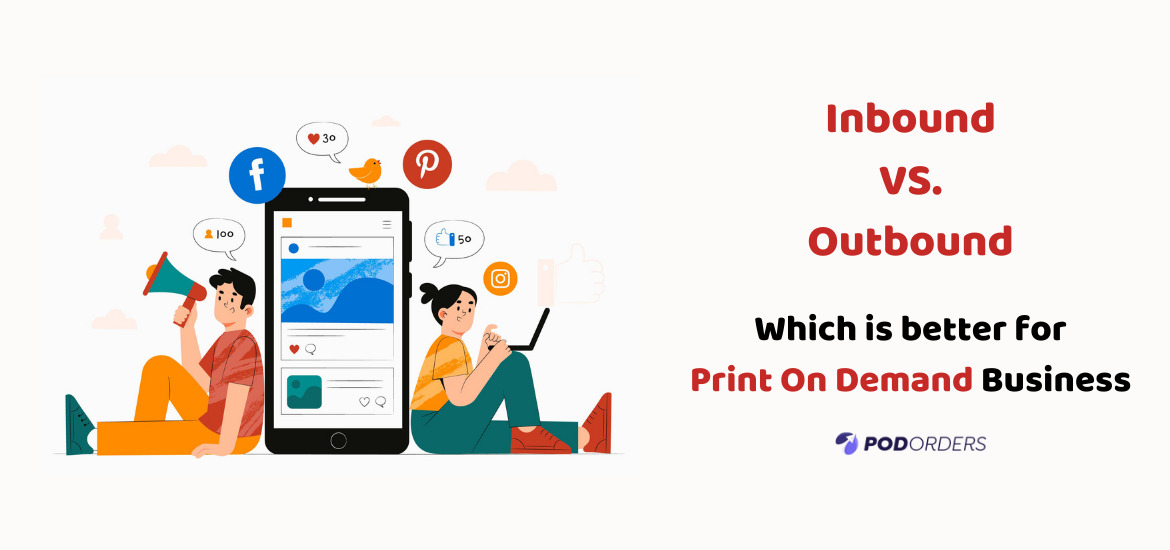Inbound Marketing Vs. Outbound Marketing has always been a familiar term in marketing strategy. As a print-on-demand seller, you may wonder which tactic you should apply to your business model in order to gain the best outcome.
In this article, we will give you a basic comparison of Inbound Marketing Vs. Outbound Marketing as well as a conclusion about which one is better for Print On Demand Business.
The potential of Print On Demand Business

Print-On-Demand Business is a service that allows sellers to market their designs of white-label products, such as T-shirts, coffee mugs, phone cases, to name a few, without incurring excessive production costs.
According to EcommerceCharm, the Print-On-Demand industry is predicted to be worth approximately $2 billion US dollars by the end of 2021. This is also explain why print on demand is a lucrative business for startups to invest in.
1.1 A low-cost business
Many entrepreneurs believe that the best way to start a firm is to spend as much money as possible on mass production. However, in this socially distancing situation, it is not ideal since most of us would turn to online purchasing platforms to suit our demands.
As a result, when you need to print a small number of products for consumers, the print-on-demand business allows you to save money. You can easily maintain track of your finances, save printing costs, and change your plan to attract more potential clients after selling a certain amount of items.
1.2 No worries about storage
While some wholesale providers struggle with the vast quantity of products that seem to “stay forever” in their warehouses, print-on-demand businesses continue to develop despite this problem.
Printing precisely what you need on-demand will help you eliminate storage and focus on other aspects of your organization.
1.3 Conveniently re-custom your design
Customers appreciate your sense of style and want to purchase your goods. However, after evaluating data in the previous month and gathering feedback from prior customers, you came up with the idea of improving your brand to make more people aware of your service. Print-on-demand business can offer you that chance!
Furthermore, you are a responsible individual who spends considerable time making modifications and re-uploading. Don’t worry; the print-on-demand business model is here to help you customize your products until both you and your consumers are happy.
Inbound Marketing Strategy for Print On Demand

Inbound marketing is a strategy of building a lasting relationship between your business and your customers by accompanying them on the journey of reaching their goals. According to Hubspot, inbound marketing can proceed in three ways:
- Attract: By providing valuable content and conversations, you play a role as an advisor with whom your target audience wants to cooperate.
- Engage: Deliver information and solutions that address customer’s problems, thus helping increase their likelihood of purchasing from you.
- Delight: Conscientiously support your customers when they experience your products or service.
Below are some practical tactics that you can apply to your Print-on-demand businesses. Check out now:
2.1 Create a blog site
You may have thought that print-on-demand business lists white-label items on your website and waits for a customer to visit. However, people have various resources to browse for the products they want, so what makes you different from other competitors that customers have to choose you?
The answer is that your business has a blog site. When a customer searches for a particular product or service, it also means that they need something or have personal problems. If you create a blog whose content can show the value of your business, you will have more chances of attracting leads and boosting organic traffic to your website.

2.2 Provide helpful and high-quality content
Now that you have a blog. The next step is to build compelling content to retain your target audience. Consider your main products and make plans for your content.
For example, you can write about your product information and the benefits or value it brings. When it comes to holiday seasons, your blog content can be how-to guides or tips to choose gifts; then, you can suggest some merchandise as a meaningful present in those festive events.
How to make your content more high-quality? Build your content to be more visual by adding aesthetic and relevant images, charts or graphs. This can help your content be more approachable to your target audience rather than just a wall of text.
Don’t forget to include a significant and attractive headline. The main goal of producing quality content is to draw in new leads and customers, so creating an enticing headline can help drive more clicks to your websites.
2.3 Video Content
Another inbound strategy to take into consideration is video content. A clear illustration of this tactic is content creators on the Tiktok platform. 2021-2022 seems to be the era of Tiktok. It continues to strive more soon with short videos but relatable, and various content, helping people quickly absorb the information one’s business wants to spread.
Therefore, why not apply video content to your business model now? Choose your primary social media to launch this strategy; it can be on Facebook, Youtube or Tiktok. One small tip for your video content is not only to provide “dry content,” instead be a storyteller, educate and share your business value to the viewers.
2.4 Email Marketing

The best inbound marketing to promote new blog articles and offer helpful content to your subscribers is via email marketing. Once a customer signs up and “stays tuned” for your email, send them a welcome sequence in the first place, then step by step introduce customers to your print-on-demand offers.
Even though the ultimate purpose of email marketing is to expand your brand awareness, it is important to understand that promotions are not the core of email marketing. What is more crucial here is to build and maintain good relationships with your target audience.
Therefore, the next time if you have an unsubscriber, stop worrying and keep launching to the ones that need you rather than pursuing somebody that doesn’t want to nurture a relationship with you.
However, if you want to retain your customers, our advice is only to send an email when you have something valuable to share and constantly test email marketing to find out the best results.
2.5 Search Engine Optimization (SEO)
Understanding basic knowledge of SEO can help your content reach out to more potential audiences, thus helping convert a visitor to a customer. First and foremost, identifying the ideal keywords depending on your prospective buyers and developing highly tailored content around them. For Print-on-demand businesses, your customers probably type something like:
- custom T-shirts
- print on demand
- print on demand products
- the best print on demand websites, e.g.
Furthermore, it’s best to draw links from other websites to improve your search engine optimization. Don’t forget to use alt tags in your image and video description, as well as pay attention to your relevant meta description to help search engines easily locate your page.
Outbound Marketing Strategy for Print On Demand

Contrasted to Inbound, Outbound marketing is applied when your business actively sends messages and contacts the target audience. Following up and developing commercial connections with leads generated through these outbound tactics has traditionally been the responsibility of a company’s sales personnel.
Although the 21st century is the era of inbound marketing, it is undeniable that outbound marketing is still effective in some specific circumstances. By repeatedly imposing messages, posting letters in mailboxes, running social ads or displaying ads in public places, your business can interrupt one’s flow of activity and attract their attention.
Let’s find out the four best outbound marketing tips that still work well at the time being:
3.1 Cold Calls and Emails
Cold calls and emails seem to be time-consuming but effective in the long run. Customers may deny hearing your stories in the first place, but they will remember about your business; when they are in need, they will contact you later.
Moreover, do not be disappointed if customers hang up your phone call or put your email in the spam box. Instead, research carefully and personalize your outreach before reaching out can save time for both you and those who are not interested in your service.
When giving a cold call or email, you can simultaneously apply inbound marketing with outbound marketing by providing business value to the listener rather than simply asking what they need.

3.2 Direct Mail
After identifying your potential audience, you have to generate a direct mail list – you can utilize your company’s existing list or use a direct mail list service from a third party, which is more suitable for new or small businesses.
Like cold emails, you should make your audiences feel more connected with the ad’s content in your direct mail marketing. Make it personalized and get people engaged with the ads that are tailored to them.
Our suggestion is to pair direct mail with inbound marketing campaigns. This will help you not only have a large number of new leads and customers but also spread your business to be more well-known to people.
3.3 Social Media Ads
This strategy can also be complementary to inbound tactics.
To be more precise, in order for your social media ads to reach out to more customers, you can use high-ranked keywords to create titles and enticing content ads to make it look less like ads (as most people will choose to skip ads but follow up with useful content).
Research with social media and the best time to launch your ads campaign.
The best time to boost a post is when you see one doing exceptionally well, with many shares or likes. To boost that post, and it’s likely to skyrocket in engagement and seriously increase your social return on investment.
3.4 Trade Shows
Trade shows or offline conferences still play an essential role for some businesses who want to educate the visitors more about their service, which is more suitable for educational organizations rather than the print-on-demand industry.
Nevertheless, if you are about to launch new products in public places, you can always open trade shows, invite guests to test out your products and give constant feedback. Remember to collect the guests’ information and turn them from strangers to visitors.
Make sure to plan everything in advance, set up your sales and executive teams, schedule some pre-show meetings and actively respond on social media. Your customers may feel excited about your upcoming trade shows and may pay it a visit.
Inbound Vs. Outbound Marketing: Which one is better?

| INBOUND | OUTBOUND | |
| Opportunities |
|
|
| Challenges |
|
|
Above is the comparison of Inbound marketing vs. outbound marketing. We conclude that Inbound marketing is more suitable for print-on-demand businesses. Although it takes longer to see a clear result than outbound marketing, you can gradually build relationships with your customers and utilize the Internet to spread business values – which is also more cost-effective.
What’s next?
Kickstarting a business is never an easy task; however, being patient and daring to make mistakes can help you pinpoint the best strategies that make your business grow. What’s next is to create a detailed plan for your first marketing campaign and get ready for upcoming boosting sales seasons! Best of luck!
Read more

